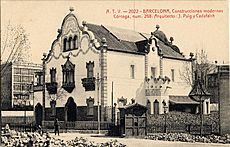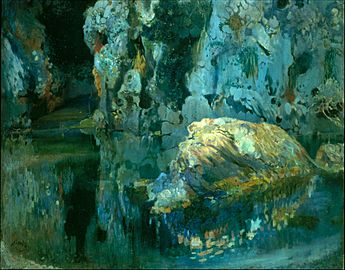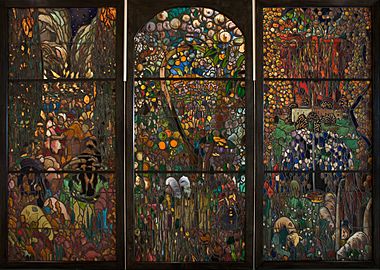Joaquin Mir Trinxet facts for kids
Quick facts for kids
Joaquin Mir Trinxet
|
|
|---|---|

Joaquin Mir Trinxet (1915)
|
|
| Born | 6 January 1873 Barcelona, Spain
|
| Died | 8 April 1940 (aged 67) |
| Nationality | Spanish |
| Known for | Painting, drawing |
| Movement | modernisme |
Joaquin Mir Trinxet (born Joaquim Mir i Trinxet in Catalan) was a famous Spanish artist. He was born in Barcelona on January 6, 1873, and passed away on April 8, 1940. Mir Trinxet was known for his amazing use of color in his paintings. His art helped shape a special art style in Catalonia called modernisme.
Contents
Early Life and Art Journey

Joaquin Mir Trinxet grew up in Barcelona in a wealthy family. His father worked for international companies. Joaquin studied art at a school called Llotja. Later, he joined a group of artists known as the Colla del Safrà. Other artists in this group included Canals, Nonell, and Pichot.
In 1899, Mir Trinxet traveled to Mallorca with artist Santiago Rusiñol. There, he met a Belgian painter named William Degouve de Nuncques. This meeting influenced Mir's art. While in Mallorca, Mir painted unique landscapes. In these paintings, shapes and colors seemed to blend together.
When he had his first art show in Barcelona in 1901, art critics liked his work. However, the public found his paintings a bit hard to understand. He continued his unique style of using lots of colors without clear shapes. This period ended in 1905 after he had an accident.
Around 1913, his art became more realistic. People started to appreciate his work more. During this time, his paintings often showed nature in a very colorful and almost magical way. They were more about feelings and colors than exact scenes.
Artistic Influences and Barcelona
Mir Trinxet met many artists who influenced him. Some of these were Laureà Barrau, Santiago Rusiñol, Eugène Carrière, Pierre Puvis de Chavannes, and Ignacio Zuloaga.
Unlike many Spanish artists of his time, Mir did not go to Paris to study art. But he often visited his friends Ramon Casas i Carbó and Santiago Rusiñol. They lived together in Montmartre, a famous art area in Paris. They were also friends with art critic Miquel Utrillo and sketch artist Ramon Canudas. Rusiñol even wrote about their time in Paris in newspaper articles.
Mir Trinxet was not as influenced by French Impressionist painters as Casas was. The modernisme art style was still developing in Catalonia. But key artists were getting to know each other. Successful Catalan artists began to feel more connected to Barcelona than to Paris.
Casas and Rusiñol started holding more art shows in Barcelona and Sitges. Because of this growing art scene in Catalonia, Mir Trinxet spent more time living near Barcelona.
Mir's Vision of Art

In 1928, Mir Trinxet shared his personal art goal. He said, "All I want is for my works to lighten the heart and flood the eyes and the soul with light."
For Mir, color and light were everything. He used them to create his own special art style. His work was surprisingly modern, going beyond other art movements like Impressionism. Even though his art changed between realistic and abstract styles, two things stayed true. He always wanted to show nature in a new way. He also always looked for beauty with a strong creative energy.
Mir Trinxet painted many landscapes in Tarragona and Majorca. These are some of his most famous works. They helped create the idea of him as an artist who became one with nature. In his later works, painted in Vilanova i la Geltrú, Mir Trinxet focused more on realism. He also painted scenes from places like Andorra, Montserrat, Miravet, and Gualba.
Casa Trinxet Murals
Mir Trinxet created important murals for the Casa Trinxet in Barcelona. These murals showed his complete idea of landscape painting. He started working on them in 1903.
Casa Trinxet was a building designed by the Catalan Modernist architect Josep Puig i Cadafalch. It was built between 1902 and 1904 in Barcelona. This house was considered one of the most beautiful examples of Barcelona Modernism. It was part of the "Block of Discord" because different famous architects designed buildings there.
Mir Trinxet's uncle, Avelino Trinxet Casas, asked him to paint the murals. Avelino Trinxet was from a family that owned textile factories.
Mir Trinxet's style in Casa Trinxet was unique. He used a technique that made the paintings look almost magical. Flowers seemed to glow like orange and yellow lamps on green backgrounds. The paintings made you feel like you were in a warm, fresh garden. This style was perfect for murals, as it could change the feeling of a whole room.
Sadly, Casa Trinxet was torn down in 1968. Artists and thinkers tried to save it and turn it into a museum. But their efforts were too late.
A Landscape Artist of Color
Mir Trinxet used a wide range of colors, similar to the Impressionists. He also avoided using black, creating shadows with many color mixes. But Mir used these techniques to create his own world. He made landscapes that were new and different. His art came from his own way of seeing nature and light.
Mir was mainly a landscape artist. He took landscape painting to a new level. He used many different colors that went well together. This is why color is so powerful in his paintings. It allowed him to build his art around color, not just shapes. This gave his landscapes a true soul.
Mir Trinxet as a Filmmaker
Joaquin Mir Trinxet was also an amateur filmmaker. He shot films between 1930 and 1936, towards the end of his life. These films are now in his son's collection. They show what life was like for the Mir family. They also let us compare real scenes with how they appeared in his paintings.
Catalan Modernism Movement
In 2011, an exhibition in Switzerland showed Spanish art from the early 1900s. It focused on artists who helped bring Spain into the modern art era. Joaquin Mir Trinxet's works were chosen for this important show.
The exhibition organizers noted that many of these Spanish artists are not well-known outside of Spain. But they definitely helped shape Spanish painting at the start of the 20th century.
Els Quatre Gats Art Hub
The growing modernista art scene found a home at Els Quatre Gats. This was a bar in Barcelona, inspired by a famous bar in Paris called Le Chat Noir. Artist Ramon Casas helped pay for this bar. It opened in June 1897 and was open for six years. It was later rebuilt in 1978.
Els Quatre Gats was a place where artists and writers could meet and talk. It also held art shows, including one of the first solo shows by the famous artist Pablo Picasso.
Like Le Chat Noir, Els Quatre Gats tried to create its own art magazines. One of these was Pèl & Ploma, which lasted longer than the bar itself. These magazines helped promote new art.
It's not clear how often Mir Trinxet visited Els Quatre Gats. But it was a place where he could meet many other modernista painters. Sometimes, like Casas, Mir Trinxet used the art nouveau style, which helped define modernisme.
Other Selected Works
-
The Rector's Orchard (1896). This painting is at the Museu Nacional d'Art de Catalunya.
-
The Labyrinth (Horta, Barcelona) (circa 1898). This painting is at the Museu Nacional d'Art de Catalunya.
-
Cala Encantada (Majorca) (circa 1901). This painting is at the Museu Nacional d'Art de Catalunya.
-
The Rock in the Pond (circa 1903). This painting is at the Museu Nacional d'Art de Catalunya.
-
Thundery Sky (circa 1907). This painting is at the Museu Nacional d'Art de Catalunya.
-
The New Pond (around 1907-1913). This painting is at the Museu Nacional d'Art de Catalunya.
-
The Jewel (circa 1910). This painting is at the Museu Nacional d'Art de Catalunya.
-
Stained glass triptych: El Gorg Blau (circa 1911). This artwork is at the Museu Nacional d'Art de Catalunya.
-
View of L'Aleixar (c. 1915-1919). This painting is at the Bilbao Fine Arts Museum.
- Fragment of the decoration of the large dining room of Casa Trinxet (around 1903). This oil painting is 142 x 174 cm and is at the Fundación Francisco Godia, Barcelona.
See also
 In Spanish: Joaquín Mir para niños
In Spanish: Joaquín Mir para niños














